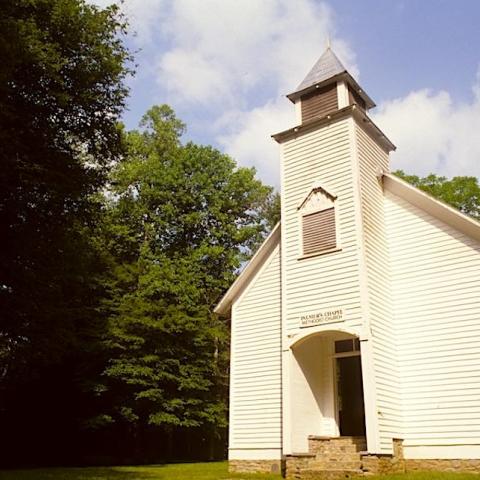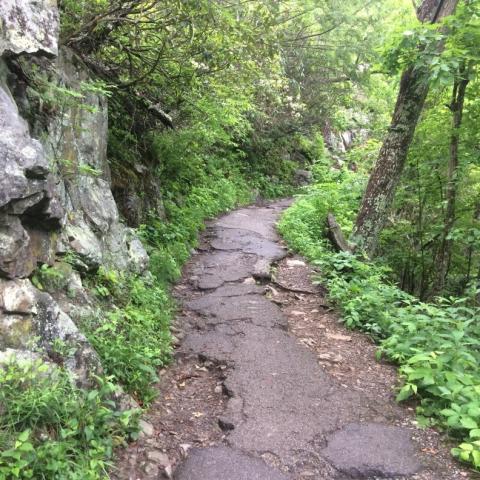A black bear thought to have been pursuing hikers for food at Great Smoky Mountains National Park was put down by rangers on Tuesday.
"At approximately 10:30 a.m. this morning, park wildlife staff captured a bear at Mount Le Conte matching the description of a bear which had exhibited rare, aggressive, predatory behavior," said park spokeswoman Dana Soehn. "The bear was captured in the same location where it was previously encountered by the park wildlife technician on Sunday. The bear is a large male weighing approximately 175 pounds.
"We humanely euthanized the bear shortly after capture. The decision to euthanize an animal of any kind in the park is never made lightly," she added. "Bears are iconic symbols in the Smokies and our staff works diligently to protect them and their habitat. The predatory behavior exhibited by this bear limited our options. We could not release an aggressive bear exhibiting predatory behavior anywhere in the park without the risk of the bear pursuing hikers or families with children in another area."
Earlier Tuesday, the park had put out a release announcing the closure of the Mount Le Conte backcountry shelter and trails to the Cliff Tops area.
On Sunday, one of the park's wildlife technicians encountered an aggressive bear near the trail to Cliff Tops that persistently approached and followed him for roughly a third-of-a-mile. Loud noises and attempts from the trained ranger to scare the bear did not deter the bear’s repeated threatening advance, park officials said, adding that "the bear followed him to the LeConte Lodge area before retreating into the forest."




 Support Essential Coverage of Essential Places
Support Essential Coverage of Essential Places







Comments
Another news outlet says the bear followed the NPS guy back to the lodge. Where he has undoubtedly been fed by lodge patrons. I have seen this many times on Leconte. No wonder the leconte lodge employees were so vocal about needing backcountry fees. Their primary concern was dogs at their lodge. Now they can be concerned about bears at "their lodge". And normal taxpayers are denied their right to stay in the $4 per night shelter but everyone that pays Leconte Lodge $150 per night is immune. Business as usual in the Smokies.
Are those bears being charged fees to use the backcountry? They'd better be or some of our friends will be whining about that, too.
This is the first time I've heard of a trail clusure due to black bear activity. I'm used to seeing it for grizzlies but not for blacks. Is this something new?
It's that time of the year. Males start getting territorial and agressive in May and June because it's their mating season. Last year, around the same time there were quite a few incidents in the Smokies involving male black bears. One followed a guy for a few miles on a trail, and another blackie was shot in the butt by some guy that claimed he was being stalked by it. Granted the bear was shot in the butt, so it must have been following him backwards. Regardless, May and June is actually a time to have your guard up, especially if you encounter male black bears. Unfortunately, the shelters can be a haven for poor camping habits. Many people leave their food out, or put trash everywhere, and this attracts bears. The shelter at leconte has quite a few bear incidents every year it seems, and it's mainly because people dont know how to camp in bear territory, and don't follow the rules. I guess this bear was hanging around the shelter and was aggressive to others.. However, it's common to find bears on LeConte, since it is prime Black Bear habitat and the mountain does have a variety of natural food sources. Last year, the Red Squirrels around Alum Cave Bluffs were beyond a nuisance becaue they became conditioned to people throwing them food... They were basically the cleanup crew on the mountain.
Gary, another good post, I have mentioned this before, but a recent book by Rachel Mazur, "Speaking of Bears", is really a good read. This is not a collection of bear stories, but an in depth look at black bear biology and a well researched history of black bear management in our National Parks. It sheds much light on the issues here and some of the points you have brought up.
Thanks for some helpful background, Gary. It's unfortunate this bear had to be put down, but given the situation as described, that was the only reasonable course of action in an area with this much public use. Yes, it's very likely improper storage of human food and trash was a big factor. Although injuries or deaths to humans from black bears are fairly rare, they do occur, and the park simply couldn't ignore this problem.
It is not improper storage of food. Bear cables work fine. It is Leconte lodge patrons feeding the bears from the safety of their heated cabins to which they retreat or on their evening walks to the Cliff Tops where this bear was habituated. Shelter visitors don't feed bears when they sleep in open, 3-sided dwellings amongst them.
John, can you remove your hater goggles for one freaking minute. It would be a nice change. ... Last year quite a few shelters had bear problems, including LeConte. THAT IS A FACT! Spence Field also had issues at points and had to be closed. A few campsites also had bear issues, mainly in the little river corridor and had to be closed. A female yearling actually kept coming into the shelter during a few nights last september at LeConte which caused them to shut it down. If you think backcountry campers are all squeaky clean, then more power to you. But they are not. I constantly try and haul out litter when i'm in the shelters, and there is always a lot laying on the ground. I'm not saying LeConte lodge guests are not part of the problem but to lay the blame entirely on guests in closed cabins, while ignoring the main culprites is a bit of a stretch. Especially when the problems are occuring mostly in the shelters.
This comment was edited to remove gratuitous language.--Ed.